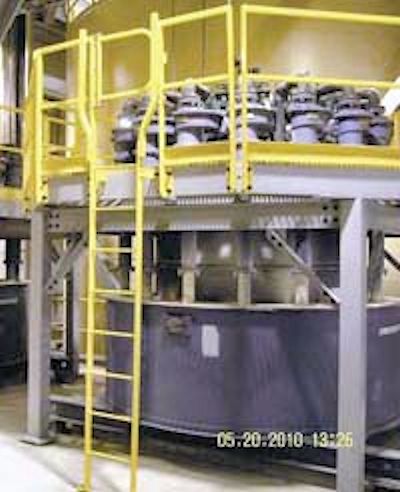Precautions
Walkways, Equipment, and Excavations
To protect employees walking working on walkways, over dangerous equipment, and excavations, follow these safe work practices:
- Established floors, mezzanines, balconies, and walkways: Use guardrails or fall arrest/restraint systems to protect employees working on established floors, mezzanines, balconies, and walkways with an unprotected side or edge six feet or more above a lower level from falling.
- Dangerous equipment: Protect employees from falls into or onto dangerous equipment, regardless of the fall distance. To protect employees use guardrails or fall arrest/restraint systems.
- Excavations: Each employee at the edge of an excavation six feet or more in depth must be protected from falling when the excavations are not readily seen because of plant growth or other visual barriers. Use guardrail systems to protect each employee at the edge of a well, pit, shaft, and similar excavation six feet or more in depth from falling.
A construction laborer was fatally injured when he fell through a floor opening to a concrete floor approximately 10 feet, 10 inches below. He was working from the second floor of a two-story home workers had completed most of the subfloor (plywood sheathing secured over floor joists). They had left a floor area open in an attic space. At the end of the shift, the victim’s lead worker asked two workers to complete the second story subfloor in the attic space. The other co-worker joined the victim and they cut two sheets of plywood sheathing and placed them over the joists in the open area in the attic space. They were not wearing fall protection. The victim's co-worker reported that he was trying to make the pieces fit into an opening that was not square and when he looked up the victim was gone. The victim had apparently stepped onto a piece of the unsecured plywood sheathing that covered part of the floor opening, and when the plywood sheathing pivoted on the floor joist, he fell through the opening.
The victim’s co-worker immediately phoned their employer who was working off-site. The victim’s employer then called the general contractor’s field manager, who was working on-site, and the field manager called 911. Emergency medical services (EMS) arrived within minutes and immediately transported the victim to an area hospital. The victim was pronounced dead in the emergency room.
NIOSH investigators concluded that, to help prevent similar occurrences, employers should:
- provide with and ensure use of fall protection
- ensure through employee training and job-site inspection that correct procedures are followed during all phases of construction
- develop, implement, and enforce a written fall protection program that complies with applicable OSHA fall prevention standards
- assign a competent person to inspect the worksite before work begins to identify fall hazards and to determine the appropriate fall prevention systems for workers
- provide all employees training in the fall protection system, fall hazard recognition, and fall protection.
Click on the link for a comprehensive report on NIOSH In-house FACE Report 2007-01
For more information on fall protection, take OSHAcademy Course 805, Fall Protection in Construction.
Knowledge Check Choose the best answer for the question.
2-5. If employees could potentially fall into or onto dangerous equipment at what fall distance must an employer protect the employee from falling?
You forgot to answer the question!

